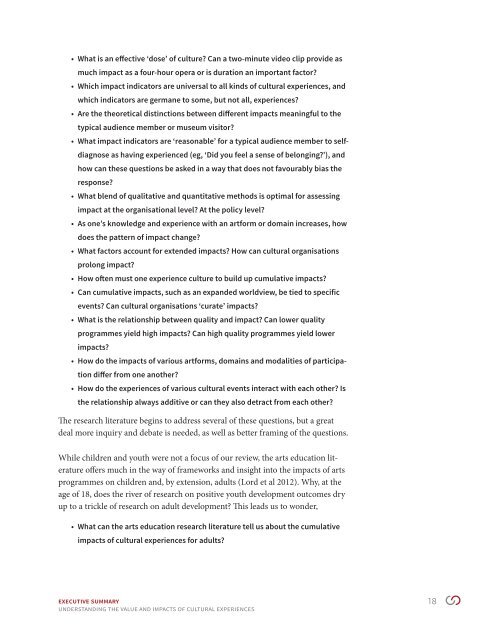aceUVi
aceUVi
aceUVi
Create successful ePaper yourself
Turn your PDF publications into a flip-book with our unique Google optimized e-Paper software.
• What is an effective ‘dose’ of culture Can a two-minute video clip provide as<br />
much impact as a four-hour opera or is duration an important factor<br />
• Which impact indicators are universal to all kinds of cultural experiences, and<br />
which indicators are germane to some, but not all, experiences<br />
• Are the theoretical distinctions between different impacts meaningful to the<br />
typical audience member or museum visitor<br />
• What impact indicators are ‘reasonable’ for a typical audience member to selfdiagnose<br />
as having experienced (eg, ‘Did you feel a sense of belonging’), and<br />
how can these questions be asked in a way that does not favourably bias the<br />
response<br />
• What blend of qualitative and quantitative methods is optimal for assessing<br />
impact at the organisational level At the policy level<br />
• As one’s knowledge and experience with an artform or domain increases, how<br />
does the pattern of impact change<br />
• What factors account for extended impacts How can cultural organisations<br />
prolong impact<br />
• How often must one experience culture to build up cumulative impacts<br />
• Can cumulative impacts, such as an expanded worldview, be tied to specific<br />
events Can cultural organisations ‘curate’ impacts<br />
• What is the relationship between quality and impact Can lower quality<br />
programmes yield high impacts Can high quality programmes yield lower<br />
impacts<br />
• How do the impacts of various artforms, domains and modalities of participation<br />
differ from one another<br />
• How do the experiences of various cultural events interact with each other Is<br />
the relationship always additive or can they also detract from each other<br />
The research literature begins to address several of these questions, but a great<br />
deal more inquiry and debate is needed, as well as better framing of the questions.<br />
While children and youth were not a focus of our review, the arts education literature<br />
offers much in the way of frameworks and insight into the impacts of arts<br />
programmes on children and, by extension, adults (Lord et al 2012). Why, at the<br />
age of 18, does the river of research on positive youth development outcomes dry<br />
up to a trickle of research on adult development This leads us to wonder,<br />
• What can the arts education research literature tell us about the cumulative<br />
impacts of cultural experiences for adults<br />
Executive Summary 18<br />
UNDERSTANDING the value and impacts of cultural experiences


